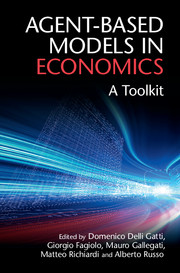Book contents
- Frontmatter
- Dedication
- Contents
- List of Figures
- List of Tables
- List of Contributors
- Preface
- 1 Introduction
- 2 Agent-Based Computational Economics: What, Why, When
- 3 Agent-Based Models as Recursive Systems
- 4 Rationality, Behavior, and Expectations
- 5 Agents’ Behavior and Learning
- 6 Interaction
- 7 The Agent-Based Experiment
- 8 Empirical Validation of Agent-Based Models
- 9 Estimation of Agent-Based Models
- 10 Epilogue
- Bibliography
- Index
7 - The Agent-Based Experiment
Published online by Cambridge University Press: 02 March 2018
- Frontmatter
- Dedication
- Contents
- List of Figures
- List of Tables
- List of Contributors
- Preface
- 1 Introduction
- 2 Agent-Based Computational Economics: What, Why, When
- 3 Agent-Based Models as Recursive Systems
- 4 Rationality, Behavior, and Expectations
- 5 Agents’ Behavior and Learning
- 6 Interaction
- 7 The Agent-Based Experiment
- 8 Empirical Validation of Agent-Based Models
- 9 Estimation of Agent-Based Models
- 10 Epilogue
- Bibliography
- Index
Summary
Introduction
This chapter deals with the problem of analysing the behaviour of an agentbased (AB) model. The problem is similar to the one faced by any modelling methodology: the researcher sets up the rules of the game, but does not know in advance the implications of those rules. Actually, it is in this a priori uncertainty about the model outcomes, and the relationship between the model outputs and the model inputs, that rests the value of developing a model. However, the techniques to gain understanding about the model behaviour differ substantially across modelling methodologies, and they remain quite underexplored in the AB literature. In a simulation model, only inductive knowledge about its behaviour can be gained by repeatedly running the model under different samples from the parameter space.
The analysis of this inductive evidence has to confront with the a priori unknown stochastic properties of the model. The easiest case is when, for any values of the parameters, the model is stationary and ergodic: in these circumstances it is generally possible, with a reasonable number of experiments, to characterise both the equilibrium properties of the model and the adjustment dynamics to the equilibria. On the other hand, non-stationarity renders the analytical concepts of equilibrium and adjustment dynamics inapplicable, while non-ergodicity might hinder the same possibility of fully describing the behaviour of the model. A preliminary analysis to discriminate between these cases is therefore necessary, and it can only be done by statistical testing. In this chapter, we will provide examples of the tests that can be used to detect both stationarity and ergodicity.
These properties in turn affect the types of subsequent analyses that can be performed, and the interpretation of the results. The techniques that are used to describe the relationships between the different variables of the model are referred to in general terms as sensitivity analysis (SA). Although a complete survey of these techniques is outside the scope of this chapter, we briefly describe them and offer an example of how they can be applied to a specific AB model.
The chapter is structured as follows. Section 7.2 introduces the notion of statistical equilibria, and discusses the effects of non-stationarity.
Information
- Type
- Chapter
- Information
- Agent-Based Models in EconomicsA Toolkit, pp. 143 - 162Publisher: Cambridge University PressPrint publication year: 2018
